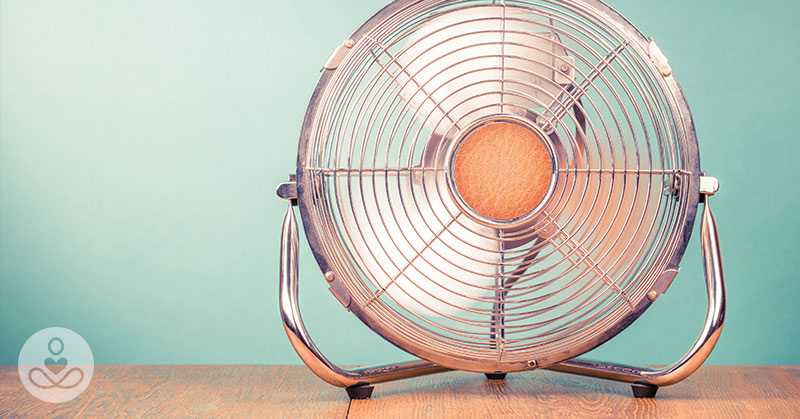A car isn’t the only place people and animals can suffer from heat-related illness and even death.
Jennifer Amba, a single mom in Canada, says her three-year-old daughter developed heatstroke while taking a nap right in her own bedroom.
Amba says she called an ambulance and while waiting for help, it took her 20 minutes to rouse her child. She says her daughter went for a nap and Amba didn’t realize how hot her bedroom was. When she found her daughter, she was soaked in sweat, red in the face, and unresponsive.
Their house didn’t have air conditioning and a fan wasn’t running, but she did leave a window open with the blinds closed.
Over 650 people in the United States alone die each year from heat-related illness that’s preventable [1]. You can be outside, in a car, or in a room—not even in the sun—and still get heatstroke.
What Exactly Is a Heatstroke?
Heatstroke is a health condition that happens when the body is unable to cool itself down and its temperature reaches 104 degrees Fahrenheit.
The body can normally keep itself cool and regulate its temperature; however, if someone has spent a lot of time in the heat and isn’t getting enough fluids, the body can become dehydrated, which makes it impossible for the body to cool itself through sweating.
The person will then become sick. Usually, heat exhaustion happens first, which can cause symptoms such as a headache, fatigue, or nausea and muscle cramps. If nothing is done to reduce the body temperature, the condition can quickly escalate to a heatstroke [2].
When Does Heatstroke Happen?
Heatstroke happens when exposure to a hot environment leads to a rise in body temperature. This could happen during intense physical exercise or physical activity in hot weather, especially if you’re not used to higher temperatures.
If you’re wearing improper clothing that prevents your body from properly sweating (the sweat will evaporate and cool on your skin, bringing down your body temperature), heatstroke can happen. Alcohol also plays a role in heat-related illness, as it interferes with your body’s ability to regulate its temperature [3].
Who is most at risk? While children and babies have a harder time regulating their body temperature and can get overheated more easily, so can people over the age of 65, pregnant or nursing women, and chronically ill people or people with existing medical conditions are more likely to get heatstroke [4].
Symptoms of Heatstroke
Early symptoms of heatstroke as the body’s temperature rises could include goose bumps or tingling skin, a dull headache, and nausea [5]. Some people may also vomit.
As the body’s temperature reaches 104 degrees—which is when heatstroke officially sets in—people may be confused or lethargic and difficult to rouse. The heart is strained due to dehydration and increased blood flow to the skin. The person may or may not be sweating a large amount.
In the past, it was thought that people only had heatstroke when they weren’t sweating, as the body was so dehydrated that it couldn’t sweat to cool itself down. However, research shows that sweating only ceases in about 50 percent of people with heatstroke, meaning the remaining 50 percent will continue to sweat even as heatstroke is taking place [5].
Heatstroke can also cause difficulty breathing, a rapid pulse, disorientation, and flushed skin [6]. Heatstroke can eventually lead to organ damage and death if not treated. It has the potential to damage the brain, lungs, liver, and kidneys [7]. Knowing when heatstroke is happening can save someone’s life!
How to Identify Heatstroke and What to Do if You Suspect It (It’s an Emergency!)
Heatstroke is an emergency as it can lead to death. Call your emergency number or get the person to a hospital as soon as possible!
A person may have heatstroke if they are unresponsive or disoriented, have red or flushed skin, have a rapid pulse, and are hot to the touch. Remember, the person may be sweaty or not sweaty when heatstroke is happening.
While you wait for emergency help, you can take the following steps [8]:
- Get the person into an air-conditioned space or at least a shady area.
- Remove any unnecessary clothing.
- Fan the patient and/or wet their skin with water if possible.
- If the person is not elderly, a young child, chronically ill, or has incurred heatstroke due to physical exercise, you can place ice packs on their body, particularly in areas that have a higher concentration of blood vessels such as the armpits, neck, back, and groin.
- If you are able, immerse the person in cool water.
A Note on Our Furry Friends
As a devoted rabbit mama and animal lover, it’s important that we don’t leave our animal friends out of this article.
Animals are just as affected, if not more, by the heat than humans. Many animals (like my bunnies) have coats of hair that can cause them to overheat faster than humans—imagine being outside in 90-degree weather with a fur coat on.
Pets that experience heat exhaustion or heatstroke may have difficulty breathing, may excessively pant or drool, and may be weak or collapse. As soon as you notice they may be overheated, you can put a fan on your pet or wrap them in a towel soaked with lukewarm water (don’t use cold or cool water; animals cool down fast and cold therapy could make them sick) [9].
To prevent heatstroke in pets, ensure your furry companion has access to shade and is away from direct sunlight in hotter temperatures, and always be sure they have fresh water. You may also choose to avoid exercising your pets during the hotter part of the day.
If you believe your pet is suffering or has suffered from heat exhaustion or heatstroke, call your veterinarian for further guidance on how to help your pet!
How You Can Prevent Heat Stroke
Preventing heatstroke can help you avoid a life-threatening condition. You can avoid heatstroke by [10].
- Staying hydrated and drinking plenty of water throughout the day.
- Not wearing excess clothing in higher temperatures; wear light and loose-fitting clothing if possible.
- Don’t drink alcohol, especially in excess, as it can prevent your body from recognizing how hot it is.
- Wear a hat and sunglasses when outdoors, and consider wearing natural sunscreen.
- Never leave a person or a pet in a parked car; animals and people can suffer heatstroke even when outside temperatures are as low as 70 degrees Fahrenheit.
Many people don’t realize just how serious heatstroke can be. It’s life-threatening and requires prompt treatment so a person can recover. As Jennifer Amba found out, you don’t need to be outside in the sun to get heatstroke! Luckily her daughter made a full recovery.
- https://www.cdc.gov/pictureofamerica/pdfs/picture_of_america_heat-related_illness.pdf
- https://www.health.harvard.edu/a_to_z/heat-stroke-hyperthermia-a-to-z
- https://www.mayoclinic.org/diseases-conditions/heat-stroke/symptoms-causes/syc-20353581
- https://www.betterhealth.vic.gov.au/health/healthyliving/heat-stress-preventing-heatstroke
- https://www.npr.org/2011/07/21/138586969/what-happens-when-the-body-overheats
- https://www.medicinenet.com/heat_stroke/article.htm
- https://www.medicalnewstoday.com/articles/321972.php
- https://www.webmd.com/a-to-z-guides/heat-stroke-symptoms-and-treatment#2
- https://www.aaha.org/pet_owner/lifestyle/heatstroke-and-your-pet.aspx
- https://intermountainhealthcare.org/blogs/topics/live-well/2017/06/5-ways-to-prevent-heat-stroke/
- https://www.parents.com/toddlers-preschoolers/everything-kids/mom-shares-urgent-warning-after-daughter-suffers-heat-stroke/?fbclid=IwAR37Vaw3CyAPzjKEwaeZazfP3i-WA0HIYRv-2UvNRCXQl8LCbG7vLUctxPI

